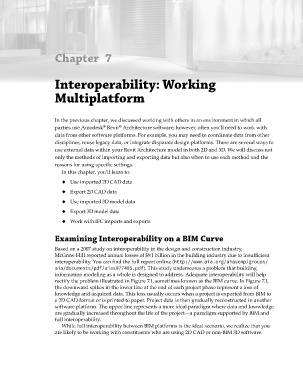Page 263 - Divyank Tyagi
P. 263
Chapter 7
Interoperability: Working
Multiplatform
In the previous chapter, we discussed working with others in an environment in which all
®
parties use Autodesk Revit Architecture software; however, often you’ll need to work with
®
data from other software platforms. For example, you may need to coordinate data from other
disciplines, reuse legacy data, or integrate disparate design platforms. There are several ways to
use external data within your Revit Architecture model in both 2D and 3D. We will discuss not
only the methods of importing and exporting data but also when to use each method and the
reasons for using specific settings.
In this chapter, you’ll learn to:
◆ ◆◆ Use imported 2D CAD data
◆ ◆◆ Export 2D CAD data
◆ ◆◆ Use imported 3D model data
◆ ◆◆ Export 3D model data
◆ ◆◆ Work with IFC imports and exports
Examining Interoperability on a BIM Curve
Based on a 2007 study on interoperability in the design and construction industry,
McGraw-Hill reported annual losses of $9.1 billion in the building industry due to insufficient
interoperability. You can find the full report online (http://www.aia.org/aiaucmp/groups/
aia/documents/pdf/aias077485.pdf). This study underscores a problem that building
information modeling as a whole is designed to address. Adequate interoperability will help
rectify the problem illustrated in Figure 7.1, sometimes known as the BIM curve. In Figure 7.1,
the downward spikes in the lower line at the end of each project phase represent a loss of
knowledge and acquired data. This loss usually occurs when a project is exported from BIM to
a 2D CAD format or is printed to paper. Project data is then gradually reconstructed in another
software platform. The upper line represents a more ideal paradigm where data and knowledge
are gradually increased throughout the life of the project—a paradigm supported by BIM and
full interoperability.
While full interoperability between BIM platforms is the ideal scenario, we realize that you
are likely to be working with constituents who are using 2D CAD or non-BIM 3D software.
c07.indd 229 5/3/2014 10:48:52 AM

